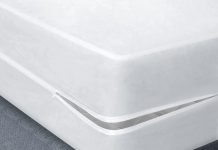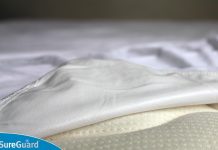Are you waking up feeling itchy and uncomfortable? Has your mattress protector seen better days? In this article, we will explore the telltale signs that indicate it’s time to replace your mattress protector. From stains and odors to tears and wear, we’ll guide you through the signs to ensure you’re getting a good night’s sleep on a clean and protected mattress. Don’t let a worn-out mattress protector spoil your sleeping experience; let’s dive into the signs you should look out for!
Review contents
Visible Stains and Spills
Food and Beverage Stains
One telltale sign that your mattress protector may need replacing is the presence of visible food and beverage stains. Accidents happen, and spills are bound to occur from time to time, especially during late-night snacking or breakfasts in bed. While a quality mattress protector should be able to prevent these stains from seeping into your mattress, over time, they can accumulate and become more difficult to remove. If you notice stubborn food or beverage stains on your mattress protector, it may be time to consider getting a new one.
Sweat and Body Fluid Stains
Another common issue with mattress protectors is the accumulation of sweat and body fluid stains. We all sweat during the night to some extent, and our bodies naturally produce oils that can transfer to the mattress protector. While the primary purpose of a mattress protector is to prevent these fluids from seeping into the mattress, they can still leave visible stains on the protector’s surface. If you find that your mattress protector is starting to show signs of sweat or body fluid stains that persist even after washing, it’s a clear indication that it’s time for a replacement.
Pet Messes and Stains
For those of us with furry friends, pets can occasionally have accidents on our beds. Whether it’s a hairball, urine, or any other form of pet mess, these incidents can leave unpleasant stains and odors on our mattress protectors. While many protectors are designed to be resistant to pet messes, prolonged exposure or repeated accidents can compromise their effectiveness. If you notice that your mattress protector is retaining pet stains or odors, it’s a good sign that it’s time to get a new one.
Odor
Persistent Smells
One of the less pleasant signs that your mattress protector may need replacing is the presence of persistent smells. Over time, body sweat, oils, and other fluids can accumulate on the protector’s surface, leading to a buildup of unpleasant odors. Even with regular washing, these smells can persist and become difficult to eliminate fully. If you find that your mattress protector has an ongoing odor issue, despite your best efforts to clean it, it’s a clear indication that it’s time for a fresh protector.
Accumulated Sweat and Body Odor
Similarly, the accumulation of sweat and body odor can be a significant sign that your mattress protector needs replacing. Our bodies naturally produce sweat and oils as we sleep, and although a quality protector should prevent these fluids from reaching the mattress, they can still accumulate on the surface. Over time, these substances can create an unpleasant smell that lingers even after washing. If you notice a persistent sweat or body odor on your mattress protector, it’s likely time to invest in a new one.
Pet Odor
If you have pets, you may also encounter the issue of pet odors on your mattress protector. Regardless of how well-trained your furry friend may be, accidents can happen, and odors can linger on the protector’s surface. While some protectors are designed to resist pet odors, repeated exposure or improper cleaning can lead to an unpleasant smell that doesn’t seem to go away. If you find that your mattress protector has a persistent pet odor, it may be a sign that it’s time for a replacement.
Torn or Ripped
Frays and Tears
One of the more obvious signs that your mattress protector needs replacing is the presence of frays and tears. Over time, regular use and washing can cause wear and tear on the protector’s fabric. If you notice visible fraying or tears in the material, it’s a clear indication that the protector is no longer providing optimal protection for your mattress. Additionally, frays and tears can allow stains, odors, and even pests to penetrate the protector, putting your mattress at risk. When torn or ripped, it’s time to invest in a new mattress protector.
Holes and Punctures
In addition to frays and tears, holes and punctures are another noticeable sign that your mattress protector may need replacing. Sharp objects, accidental pokes, or even the claws of pets can cause damage to the protector’s surface. Once holes or punctures are present, the protector’s ability to shield your mattress from stains, odors, and allergens is compromised. If you find any visible holes or punctures in your mattress protector, it’s time to consider a new one to ensure the continued protection of your mattress.
Exposed Mattress
Perhaps the most critical sign that your mattress protector needs replacing is when your mattress becomes exposed due to the protector’s deterioration. Over time, the wear and tear on a protector can become severe, causing it to lose its shape, slip off, or otherwise fail to provide proper coverage for your mattress. When this happens, the mattress becomes vulnerable to stains, odors, allergens, and even physical damage. If you find that your mattress protector is no longer adequately covering and protecting your mattress, it’s time to invest in a new one to preserve the lifespan and comfort of your mattress.
Allergies and Sensitivities
Increased Allergy Symptoms
If you notice an increase in allergy symptoms, such as sneezing, coughing, or itchy eyes, it may be a sign that your mattress protector needs replacing. Over time, allergens, dust mites, and other irritants can accumulate on your mattress protector, especially if it’s not effectively blocking them from reaching the mattress. As these allergens build up, they can trigger allergies and sensitivities, making your sleep less restful and enjoyable. If you find that your allergy symptoms are becoming more frequent or severe, it’s worth considering a new mattress protector.
Respiratory Issues
In addition to allergy symptoms, a deteriorating mattress protector can contribute to respiratory issues. Dust mites, pet dander, and other airborne particles can become trapped in the protector’s fabric, worsening air quality in your sleep environment. Breathing in these irritants night after night can lead to respiratory discomfort, such as wheezing, coughing, or difficulty breathing. If you notice an increase in respiratory issues, it’s essential to assess the condition of your mattress protector and consider replacing it if necessary.
Skin Irritation
A deteriorating mattress protector can also cause skin irritation, especially for individuals with sensitive skin. Over time, the accumulation of sweat, oils, and other body fluids can create an environment conducive to bacterial or fungal growth. This can result in skin conditions such as rashes, itching, or even acne breakouts. If you notice persistent skin irritation that seems to worsen when you sleep, it may be time to replace your mattress protector to provide a cleaner and healthier sleep surface.
Decreased Waterproofing
Leaks and Seepage
A significant sign that your mattress protector needs replacing is a decrease in its waterproofing capabilities. Whether it’s due to wear and tear, improper cleaning, or the age of the protector, leaks and seepage can occur when the protector is no longer able to effectively repel liquids. If you find that spills or accidents are causing wetness or staining on your mattress, it’s a clear indication that your mattress protector is compromised and in need of replacement.
Moisture Trapped
In addition to leaks and seepage, a deteriorating mattress protector may trap moisture instead of allowing it to evaporate. Over time, the accumulation of sweat, spills, or high humidity levels can create a damp environment between the protector and the mattress, providing an ideal breeding ground for mold and mildew. This can lead to unpleasant smells, potential health risks, and even damage to the mattress itself. If you notice an excess of moisture or a damp feeling on your mattress, it’s crucial to replace the protector to prevent further issues.
Ineffective Protection
Ultimately, the purpose of a mattress protector is to provide effective protection for your mattress. If you find that your protector is consistently failing to prevent liquids from reaching the mattress or is allowing stains and odors to penetrate, it’s a clear indication that it’s no longer fulfilling its intended function. Ineffective protection can expose your mattress to potential damage, reduce its lifespan, and compromise your sleep environment. When your mattress protector is no longer providing reliable protection, it’s time for a replacement.
Uneven Wear and Tear
Thin or Worn Areas
Uneven wear and tear on a mattress protector can manifest in various ways, with thin or worn areas being one of the most noticeable signs. These areas may result from repeated friction, rubbing against bedding, or regular use over time. When certain sections of the protector become visibly thinner or worn, its ability to offer consistent protection for your mattress is compromised. Thin areas on the protector can allow stains, odors, and allergens to penetrate, putting your mattress at risk. If you notice any thin or worn areas on your mattress protector, it’s a clear indication that it’s time to get a new one.
Indentations or Depressions
Another sign of uneven wear and tear is the presence of indentations or depressions on the surface of the mattress protector. These can occur due to continued pressure from the body, the weight of bedding, or repetitive movements during sleep. When indentations form, the protector may not be able to maintain an even barrier between your body and the mattress, compromising its protective qualities. If you notice significant indentations or depressions on your mattress protector, it’s time to consider replacing it to ensure consistent coverage and protection for your mattress.
Loose or Unstable Fit
Uneven wear and tear can also lead to a loose or unstable fit of the mattress protector on your bed. Over time, the elastic bands, corner straps, or any other securing mechanisms may become stretched, worn out, or ineffective. As a result, the protector may shift or move during sleep, leaving areas of your mattress exposed and vulnerable. A loose or unstable fit also increases the chances of the protector slipping off the mattress entirely. If you find that your mattress protector no longer fits securely or appears loose, it’s a clear sign that it’s time to invest in a new one for proper protection and peace of mind.
Uncomfortable Sleep Experience
Lumpy or Bumpy Surface
A deteriorating mattress protector can lead to an uncomfortable sleep experience due to the formation of a lumpy or bumpy surface. Over time, the protector’s material may clump or lose its original shape, causing unevenness or discomfort when you lie down. Additionally, frays, tears, or holes in the protector can create lumps or bulges that can be felt through your sheets. If you find that your mattress protector is no longer providing a smooth and comfortable surface for sleeping, it’s time to consider replacing it to improve your overall sleep experience.
Excessive Noise
Some mattress protectors may develop a noise issue over time, creating a crinkling or rustling sound whenever you move during sleep. This noise can be caused by the deterioration of the protector’s waterproofing or protective layers, resulting in a less silent sleep experience. If you find that your mattress protector has become excessively noisy, it’s worth considering a replacement to restore tranquility to your bedtime routine.
Reduced Comfort and Support
Lastly, a deteriorating mattress protector can contribute to reduced comfort and support during sleep. As the protector loses its original shape, thickness, or padding, it may compromise the ability to provide the desired level of comfort or support for your body. This can lead to restless nights, back pain, or discomfort while sleeping, ultimately affecting the overall quality of your sleep. If you notice a decline in comfort or support from your mattress protector, it’s essential to address the issue and replace it to enhance your sleep experience.
Difficulty Cleaning
Ingrained Stains
If you find that your mattress protector has ingrained stains that are difficult to remove, it may be a sign that it’s time for a replacement. Over time, even with regular cleaning, certain stains may become engrained or set within the protector’s fabric. These stains can be challenging to eliminate entirely, reducing the protector’s overall aesthetics and cleanliness. If your mattress protector has stubborn, ingrained stains that persist after cleaning efforts, it’s a clear indication that a new protector is needed.
Lingering Odor
Similarly, a deteriorating mattress protector may develop a lingering odor that cannot be eliminated through regular cleaning. Odors from sweat, body fluids, pet accidents, or other sources can penetrate the fabric and become deeply seated within the protector. Despite washing attempts, these odors may persist, affecting the freshness and overall hygiene of your sleep environment. If you find that your mattress protector has a lingering odor that does not dissipate, it’s time to invest in a new protector for a clean and refreshing sleeping experience.
Inefficiency in Washing
Over time, an aging mattress protector may become less responsive to regular washing or cleaning efforts. The fabric may lose its original properties, such as water repellency or stain resistance, making it challenging to restore the protector’s cleanliness effectively. If you notice that your mattress protector is becoming increasingly difficult to clean, even with proper washing techniques, it’s a clear indication that the protector’s effectiveness has diminished. When cleaning becomes inefficient and your protector no longer maintains its fresh and clean appearance, it’s time to consider a replacement.
Outdated or Damaged Materials
Expired Warranty
While not a visible sign, the status of your mattress protector’s warranty can provide an important indication of when it’s time for a replacement. Most protectors come with a warranty period, typically ranging from a few years to a decade or more. If your mattress protector’s warranty has expired, it means that the manufacturer no longer guarantees its performance or quality over time. Once a warranty period ends, it’s wise to assess the condition of your protector and consider investing in a new one for continued protection and peace of mind.
Advanced Wear and Tear
A clear visual sign that your mattress protector requires replacement is advanced wear and tear. When the protector’s fabric shows extensive signs of damage, such as fraying, thin spots, or pronounced discoloration, it indicates a significant decline in its quality and effectiveness. Advanced wear and tear compromise the protector’s ability to protect your mattress adequately, leaving it exposed to potential damage or contamination. If your mattress protector visibly exhibits advanced wear and tear, it’s time to invest in a new one to ensure optimal protection for your mattress.
Defective or Failing Components
In some cases, the components of your mattress protector may become defective or start to fail over time. Elastic bands may lose their elasticity, corner straps may weaken or tear, or any other securing mechanisms may become ineffective. When these components fail, the overall function and performance of the protector are compromised, reducing its ability to stay securely in place and provide reliable protection for your mattress. If you notice any defects or failing components on your mattress protector, it’s crucial to replace it to maintain the highest level of performance and functionality.
Overall Mattress Health
Exposing Mattress to Dust and Dirt
A worn-out or damaged mattress protector can inadvertently expose your mattress to dust and dirt. As the protector loses its ability to form a barrier between your body and the mattress, particles from your surroundings can settle on the unprotected surface. Over time, this can lead to a buildup of dust, dirt, and other debris that can negatively impact your sleep environment and the longevity of your mattress. If you notice an increase in dust or dirt on your mattress, it’s essential to replace your protector to maintain the overall health and cleanliness of your sleep environment.
Negatively Impacting Hygiene
A deteriorating mattress protector can have adverse effects on the hygiene of your sleep environment. Whether it’s due to stains, odors, allergens, or inadequate protection, an aging protector can compromise your ability to maintain a clean and healthy sleeping surface. Poor hygiene can potentially lead to respiratory issues, skin irritations, or infections over time, significantly affecting your overall well-being. If you find that your mattress protector is negatively impacting the hygiene of your sleep environment, it’s crucial to replace it promptly to restore a clean and healthy sleeping environment.
Reducing Mattress Lifespan
One of the primary roles of a mattress protector is to enhance the lifespan of your mattress by providing an extra layer of protection. However, a deteriorating mattress protector can have the opposite effect and actually contribute to a shortened mattress lifespan. When the protector fails to adequately shield your mattress from stains, spills, dust, and other contaminants, it exposes your mattress to potential damage or premature wear and tear. By replacing your deteriorating mattress protector, you can help extend the lifespan of your mattress and, in turn, optimize the value of your investment.
In conclusion, paying attention to the signs that your mattress protector needs replacing is crucial for maintaining a clean, hygienic, and comfortable sleep environment. Visible stains and spills, odor issues, torn or ripped fabric, decreased waterproofing, uneven wear and tear, uncomfortable sleep experience, difficulty cleaning, outdated or damaged materials, and the overall health of your mattress are all factors to consider when assessing the condition of your mattress protector. By promptly replacing a deteriorating protector, you can ensure optimal protection for your mattress, improve your sleep quality, and prolong the lifespan of your valuable investment. Sweet dreams!































